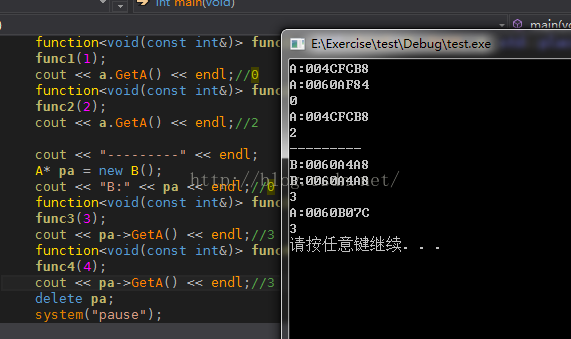1
2
3
4
5
6
7
8
9
10
11
12
13
14
15
16
17
18
19
20
21
22
23
24
25
26
27
28
29
30
31
32
33
34
35
36
37
38
39
40
41
42
43
44
45
46
47
48
| #include <iostream>
#include <functional>
using namespace std;
class A
{
public:
A() :m_a(0){}
~A(){}
virtual void SetA(const int& a){ cout << "A:" << this << endl; m_a = a; }
int GetA()const { return m_a; }
protected:
int m_a;
};
class B: public A
{
public:
B():A(){;}
~B(){;}
virtual void SetA(const int& a){ cout << "B:" << this << endl; m_a = a; }
private:
};
int main(void)
{
A a;
cout << "A:" << &a << endl;
function<void(const int&)> func1 = std::bind(&A::SetA, a, std::placeholders::_1);
func1(1);
cout << a.GetA() << endl;
function<void(const int&)> func2 = std::bind(&A::SetA, &a, std::placeholders::_1);
func2(2);
cout << a.GetA() << endl;
cout << "---------" << endl;
A* pa = new B();
cout << "B:" << pa << endl;
function<void(const int&)> func3 = std::bind(&A::SetA, pa, std::placeholders::_1);
func3(3);
cout << pa->GetA() << endl;
function<void(const int&)> func4 = std::bind(&A::SetA, *pa, std::placeholders::_1);
func4(4);
cout << pa->GetA() << endl;
delete pa;
system("pause");
return 0;
}
|
输出是:

由输出可以看出:
1、func1调用时产生了一个临时对象,然后调用临时对象的SetA;
2、func2调用的是a.SetA,改变了对象a中m_a的值;
3、func3调用的是pa->SetA,输出B:0060A4A8,调用的时B的SetA改变了pa->m_a;
4、func4调用时产生了一个临时对象,然后调用临时对象的A::SetA;
结论:std::bind中第二个参数应该是对象的指针,且std::bind支持虚函数。







